Cottage garden ideas – 32 inspiring spaces and layouts
Be inspired by these cottage garden ideas to create a plot that is charming, informal and bursting with romantic flowers
- (opens in new tab)
- (opens in new tab)
- (opens in new tab)
- Sign up to our newsletter Newsletter


If you are looking for cottage garden ideas to create a charming, characterful plot, then start with your own vision of what the space could be. Is it tumbling climbers creeping up walls, romantic drifts of softly colored perennials, or vintage containers bursting with perfumed flowers and home-grown crops?
More so than in any other garden ideas, cottage garden ideas are guided by nature. Full of self-seeding plants, tumbling blooms and rambling vines, a cottage garden is more an act of editing rather than planting.
'The cottage garden approach is ‘slow gardening’, allowing self-seeding to establish, curating the plant display and relying on plants that might be found on country roadsides like foxgloves and ferns to self-colonise. It’s really the opposite of planting in that you either leave a plant in that’s found its own way to you or you take it out,' says Claire Masset, author of Cottage Gardens (opens in new tab).
Cottage garden ideas – to inspire your scheme
Cottage garden plants are the main event when it comes to cottage garden ideas blending abundant blooms in a random way that mixes up color and form. Roses, lavender and tall spires of lupins, foxgloves and hollyhocks are the stars of the show. This style of planting softens the look of a garden, and brings you up close with scent, foliage textures and a tapestry of soothing garden color schemes.
'As a concept, a cottage garden is hard to define, but you know it when you see it. Cozy, snug, informal, profuse, the cottage garden looks entirely at home in its surroundings, as though it has slowly evolved over time – and often it has,' adds Clare.
If you want to channel your inner Gertrude Jekyll and go big on cottage garden ideas, the trick is to create an intimate space packed with color and scent, with dense planting spilling over pathways and framing windows and doors to create a serendipitous vibe.
1. Get rid of the grass

Cottage gardens provide the backbone to both cottage backyard ideas and front yard cottage ideas. In a traditional cottage garden there is no room for a lawn. Growing space is at a premium and every inch should be planted, whether that's with pretty flower bed ideas, delicious fruit or crops or scented herbs.
‘Typically the cottage garden surrounds a quaint home adorned in scented roses and climbers, is a confined space with no lawn, and intersected with paths,’ says garden expert Leigh Clapp. Pathways provide access and structure to the space while rich planting in the garden provides abundant interest and character.
2. Let you planting cover all the soil
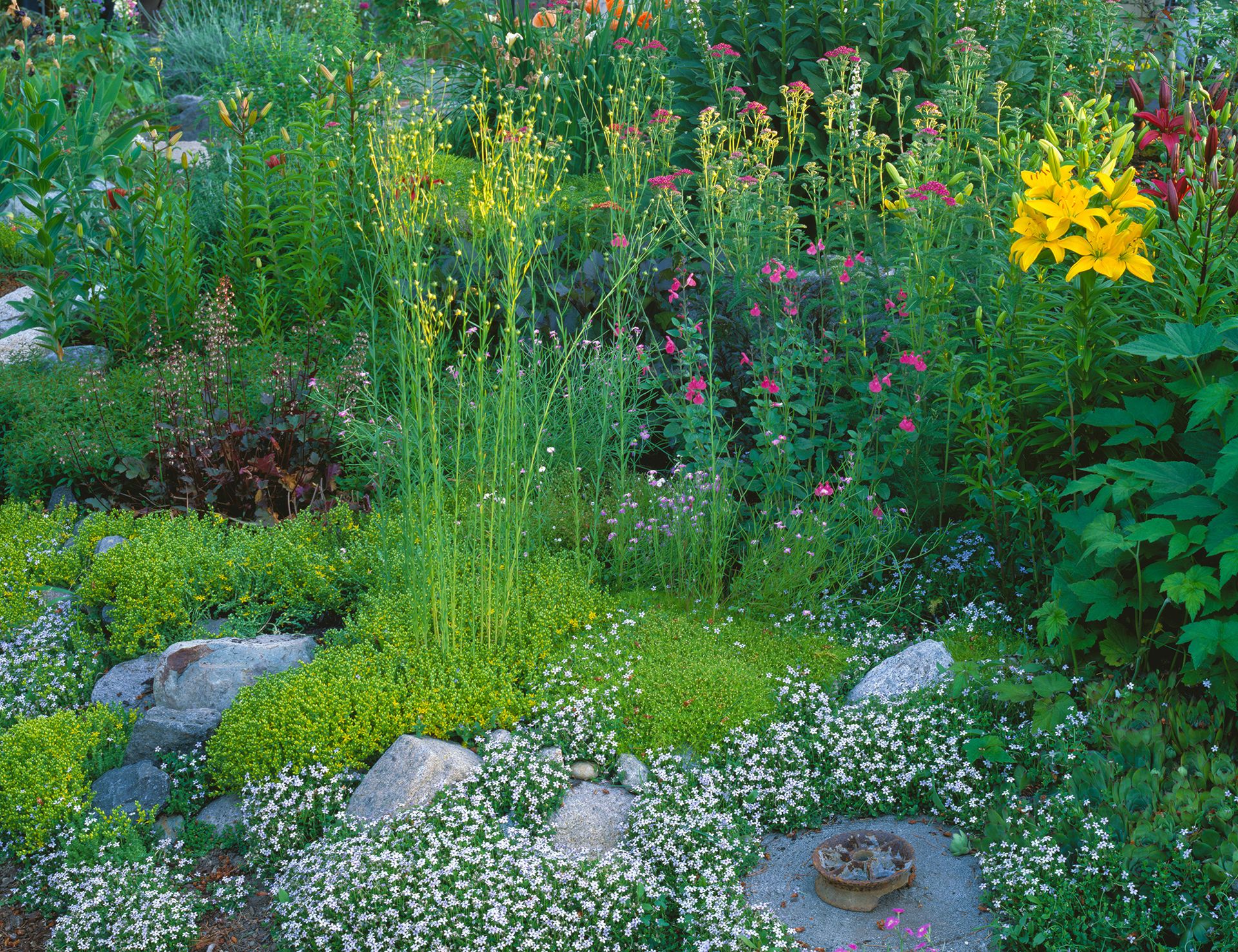
Exposed soil is a clear marker of a curated garden which stands in opposition to the freer cottage style. In order to avoid this, incorporate creeping and trailing ground cover plants into your scheme. Creeping thyme, wall germander and snow in summer are beautiful examples. Add rocks and boulders around which the plants can snake and climb to further the naturalistic edge and introduce a new texture. Don't forget to also add height to your borders, the best flowering climbers and the best flowering shrubs will ensure that there is balance to your scheme.
3. Frame your trees with blooms
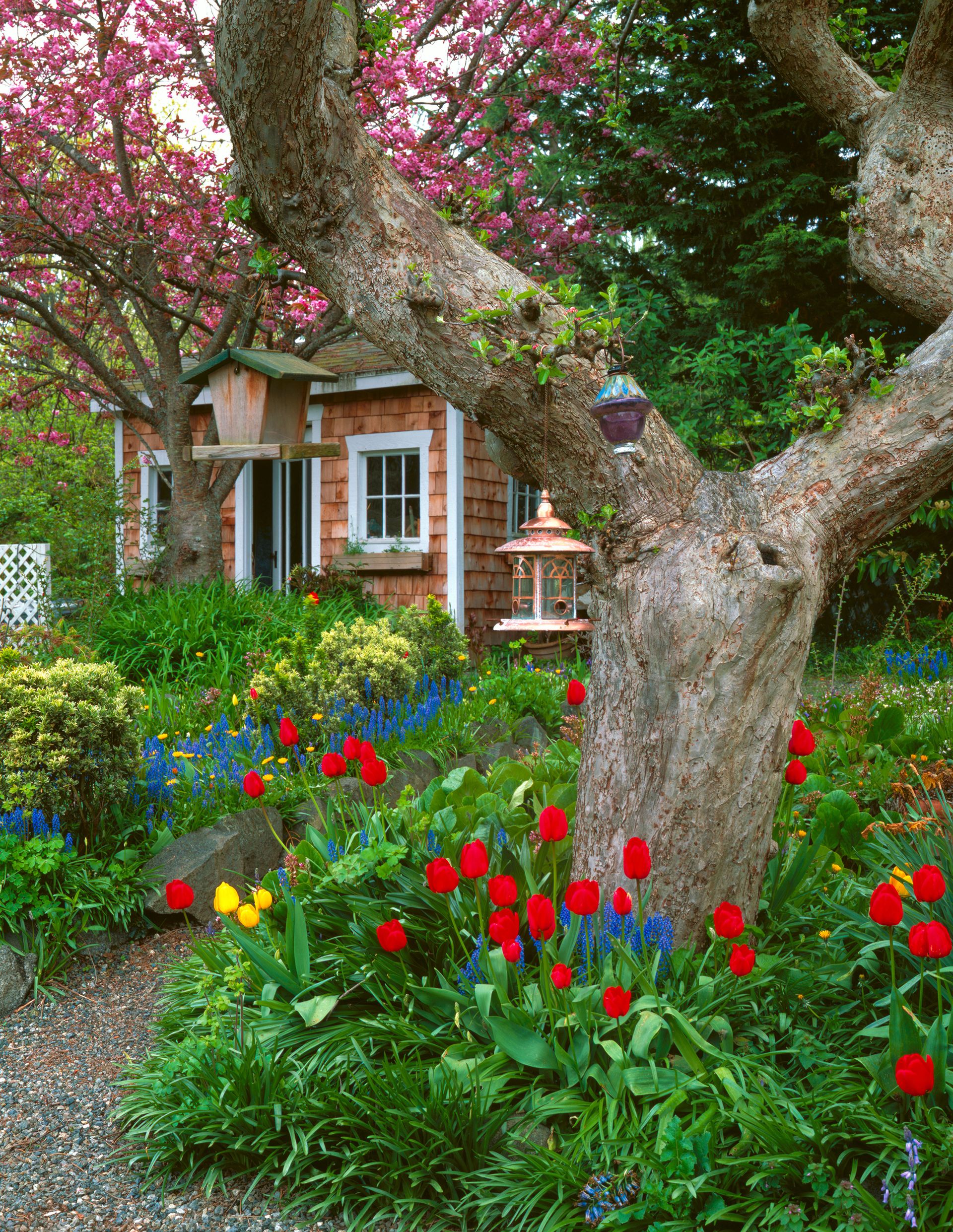
Underplanting your trees with seasonal blooms is a great way to add interest to an otherwise uninspiring part of your garden. There are many different approaches to landscaping around trees, but bulbs are one of the easiest options. Here, vibrant red tulips interspersed with naturalized grape hyacinths and dots of yellow tulips and daffodils make a painterly palette in this otherwise dead space.
The beauty of bulbs is that they are perfect for any size of garden, will divide and naturalise over time and also require minimal maintenance. Plant a mix of the best summer bulbs and the best spring bulbs to ensure a continuous display throughout the warmer months.
'The cottage garden style can be adapted to any garden, whether rural or not, small or large. Best of all, it allows for great amounts of self-expression; there are very few rules other than a profusion of plants, a love of flowers and a distinct lack of grandiosity,' adds Clare.
4. Add screening to your cottage garden
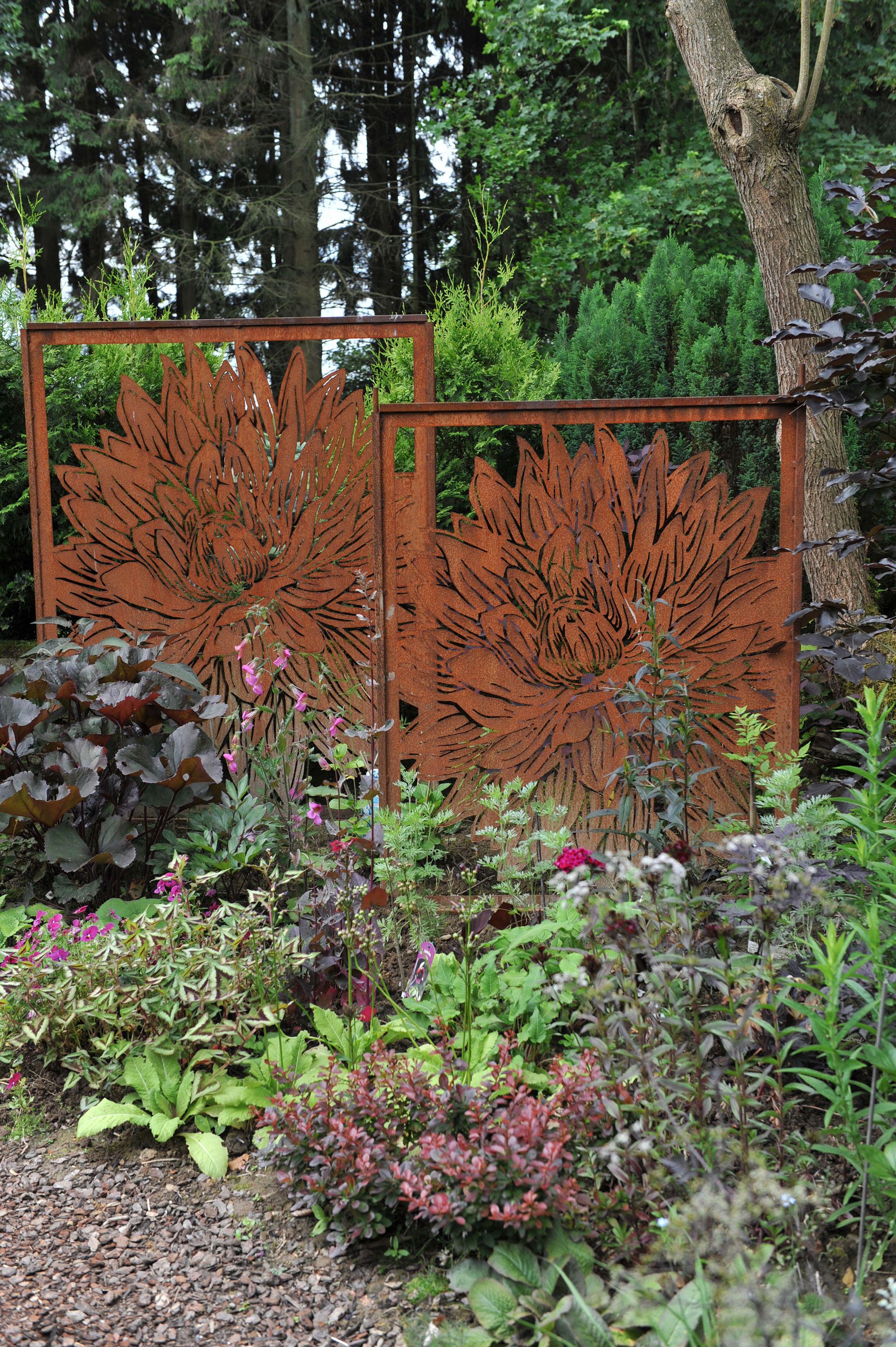
Of course, planting pretty blooms is the first part of learning how to plant a cottage garden border, however, hard landscaping is also very important in creating an aesthetically pleasing space.
In addition to providing valuable privacy, garden screening ideas will help you to zone your garden and divide the planting into specific spaces. When looking for screens to use in your cottage garden ideas, opt for a natural material such as wood to help it blend in. Alternatively, opt for an artfully aged decorative metal design for a bold statement that will add interest all year round.
5. Make your own cottage garden rules
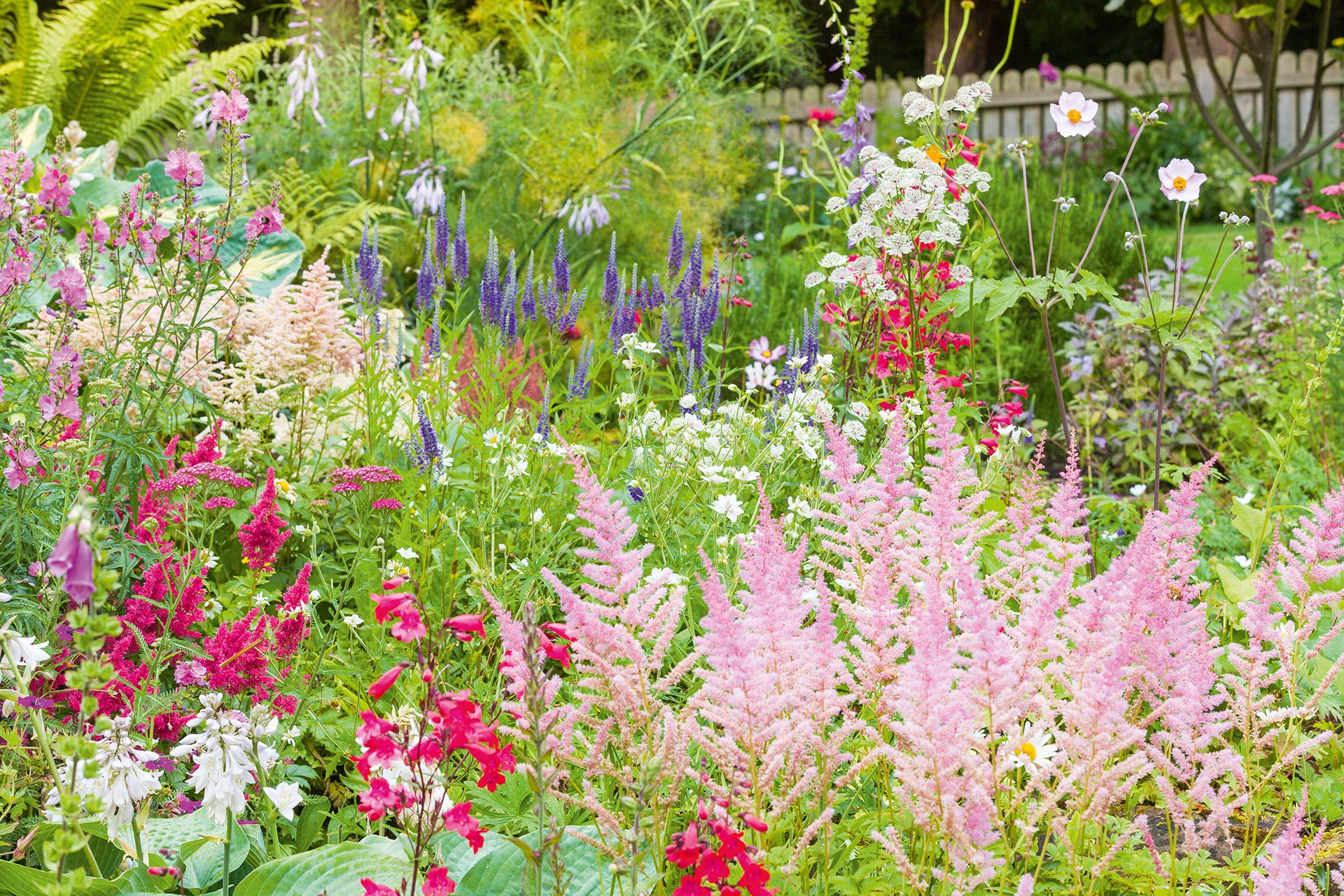
Rooted in the romance of quintessential English garden ideas, cottage garden ideas are a firm favorite and can be found alongside a wide range of house styles. No two cottage gardens are the same – your cottage garden ideas will be a reflection of your own tastes as well as drawing ideas from the exterior design of your home.
‘There is no typical cottage garden – and that’s one of the joys of cottage gardening,’ says Margaret Hensel, author of English Cottage Gardening for American Gardeners (opens in new tab). ‘Cottage gardens are individual, personal expressions. I have visited hundreds of gardens in both the UK and the US, and that is one of the points. They are the children of a gardener’s imagination and the many different sites, houses and cottages.’
Today, cottage gardening is more of an ethos than a set of rules to be followed. It's about embracing nature's beauty and intricacies, rather than forcing it to conform. Rambling, rather than rigid. Imperfectly charming, rather than perfectly chic.
While certain established cottage garden ideas will help you to get the overall look and feel, you should embrace the freedom to create a scheme that is truly unique to you and your home.
6. Pick the right flowers

According to garden designer Tracy Foster (opens in new tab) MSGD, historically, as well as being pretty to look at, the plants in a cottage garden earned their place by being easy to grow, useful, edible or a mixture of all three. When deciding on your planting schemes, take inspiration from kitchen garden ideas as well as companion planting ideas to help you combine the best mix of blooms and crops.
It’s the versatility of the cottage garden style which appeals too. Tracy suggests that ‘the resulting symphony of shape, texture, colour and scent in a seemingly unstructured layout can bring bucolic charm to any plot, even in the heart of a city.’
For a truly authentic cottage look there will be a variety of different shapes and forms in the border. Landscape and garden designer Ana Mari Bull (opens in new tab) MSGD recommends using history as a guide, ‘where possible look at modern cultivar equivalents of the plants which would have originally grown in a Victorian cottage garden. Roses are the obvious choice but they must be scented.’
Tracy Foster adds height with hollyhocks, delphiniums and foxgloves. For other flower shapes try the flat panicles of achillea, ball shaped inflorescences of globe thistle (Echinops ritro) or cheerful daisy flowers of leucanthemum or rudbeckia.
7. Install raised beds to create a sense of order amongst chaos

As has already been said, the beauty of cottage garden ideas is that there are no rules. Therefore, you don't necessarily have to embrace the floral free-for-all of traditional cottage style. There are plenty of raised bed ideas that will help to bring order to your space, while still letting you indulge in the vibrant and chaotic planting of your cottage garden ideas. Confining plants to the boxes not only makes your garden easier to navigate and tend, but also makes it easier to combine plants and crops together in one place – as you would when planning a kitchen garden.
8. Add vertical interest with climbing plants

If you’re looking for cottage garden ideas that will create the most impact, then start with the best climbing plants. There are so many varieties that can be grown upwards, and so many benefits to adding them – from covering an unsightly wall to filling the air with fragrance.
‘For millennia we have used climbing plants to green a surface or espaliered fruit against a warm wall. Arbours, arches, tunnels, trellises and pergolas can become lovely focal points adorned in profusely flowering roses entwined with clematis for example,’ says gardening expert and writer Leigh Clapp.
Roses are a classic option – consider a rambling rose, such as the repeat-flowering Phylis Bide from David Austin (opens in new tab), which will grow more quickly than a standard climber and cover a larger surface area. If you are thinking about adding roses to your cottage garden ideas, be sure you know how to plant roses and how to prune climbing roses for maximum flowers.
‘Another easy way to include vertical interest is to add some hanging baskets or containers on windowsills, balconies, along walls or displayed on stately plinths or a theatre stand,’ adds Clapp.
9. Grow plants overhead for instant drama
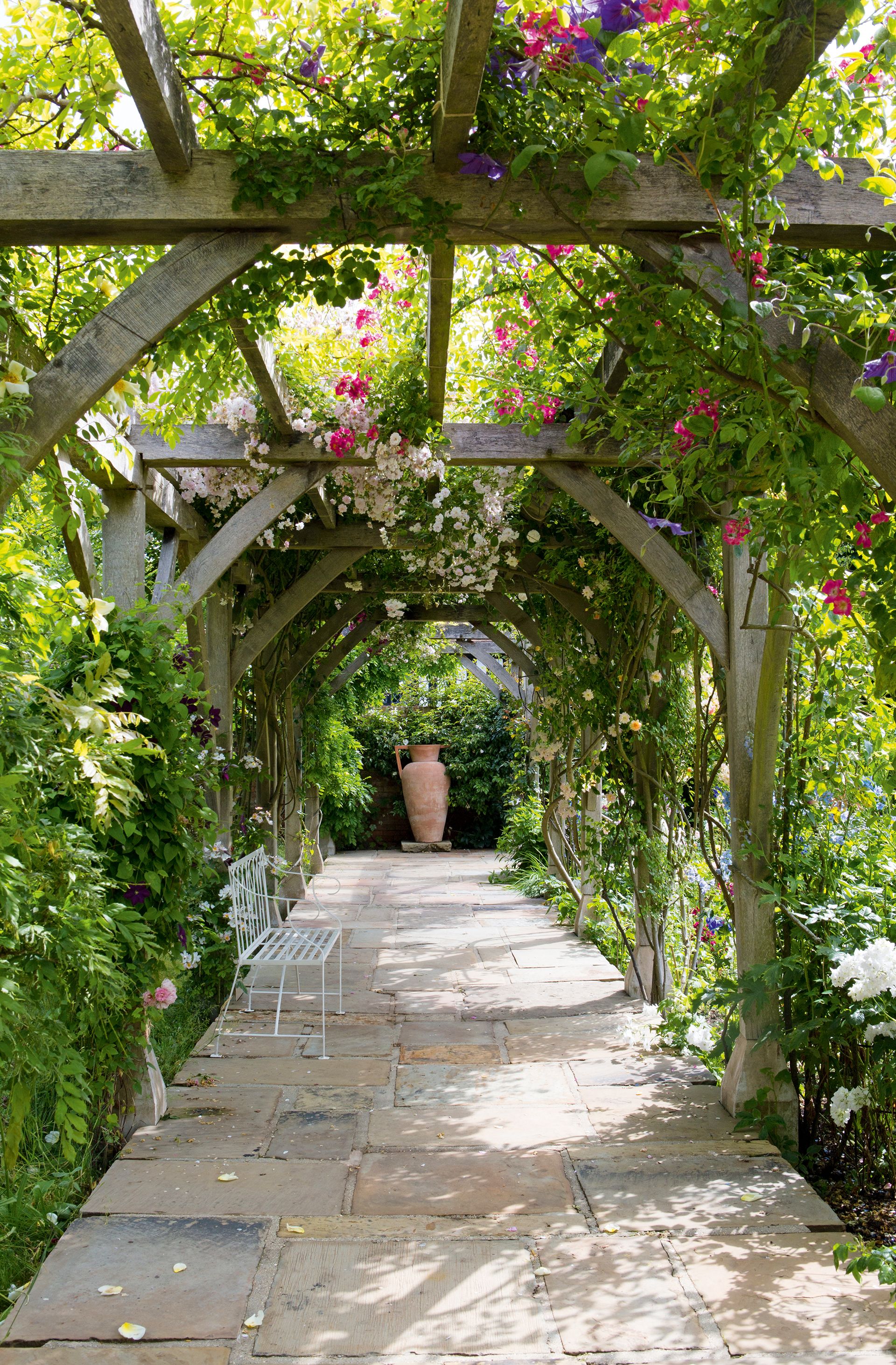
As well as growing upwards, explore the possibilities of growing plants overhead in a cottage garden, for a truly immersive experience.
Pergola ideas is ideal for this purpose and can also create a private shaded, sheltered area to escape the midday sun.
If you know how to grow wisteria, then it's the obvious choice, with its twisted branches and glorious drapes of purple flowers; but roses, clematis, honeysuckle and jasmine are all good cottage garden plants to provide overhead interest.
10. Go for a pink and mauve color palette
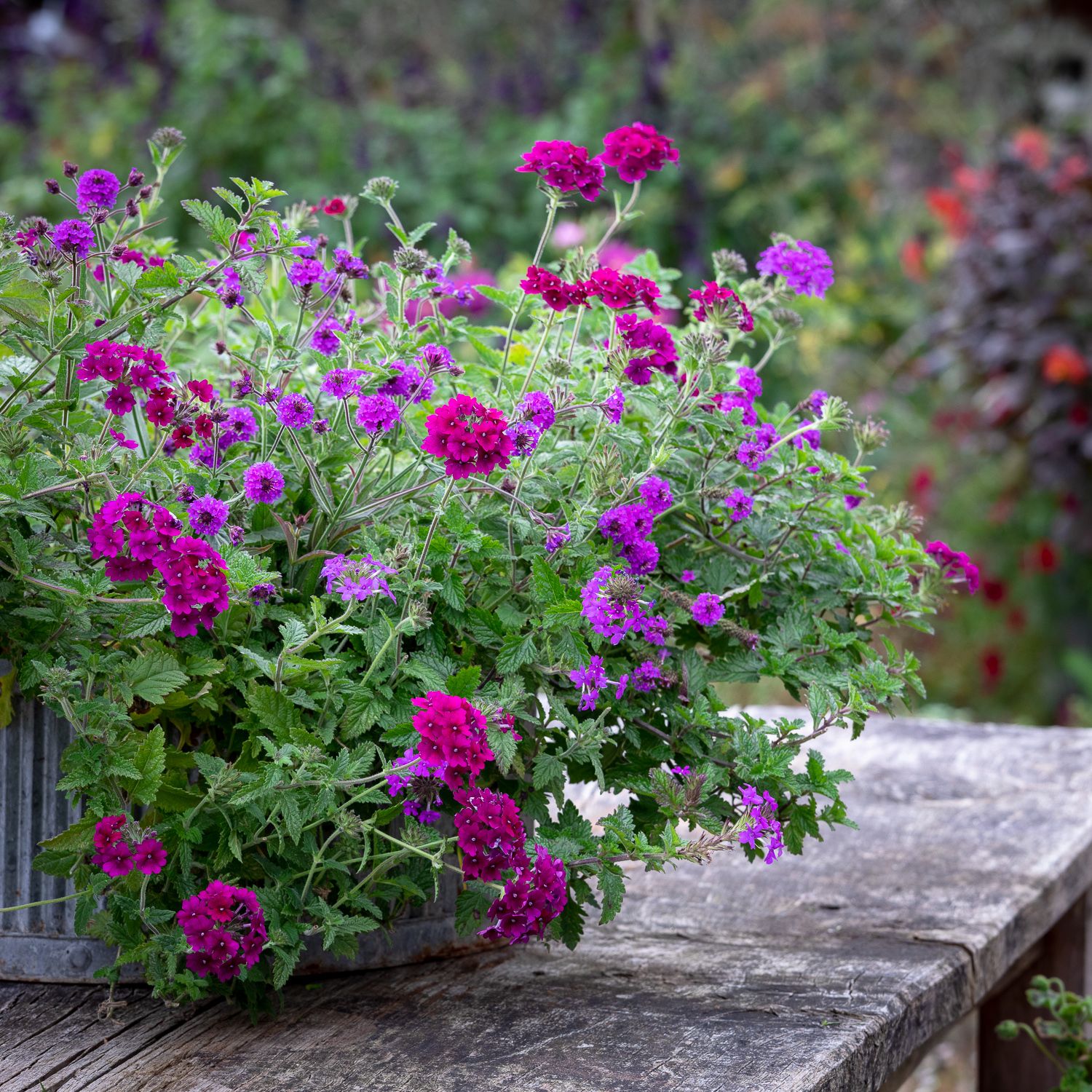
Verbena bonariensis in a mass of jewel-toned colours
Choose the right color scheme for your cottage garden look and you’re halfway there. A muted palette of soft pinks and mauves (perhaps with a dash of purple to add some drama) always works, especially if you keep things simple and stick to it.
Add in some touches of vintage cream and set the whole thing against a neutral backdrop of green and the result will be positively painterly. As you get more confident mix in some pale greys, washed out blues and silvery foliage to add depth and complexity that will segue beautifully with your look.
Where to start? With drifts of heavenly mauve lavender and ruffled old-fashioned pink roses (of course), as well as jewel-toned purple and magenta Verbena bonariensis like these beauties.
11. Plant a wildflower meadow in your cottage garden

One of the most romantic cottage garden ideas, adding wildflower garden ideas to your borders creates a sense of areas being reclaimed by nature, and, as they will be packed with plants for pollinators, is a wonderful way to attract these precious insects to your plot.
‘Meadows can be a glorious addition to the garden, whether purely wildflowers or enhanced with other species. They make a harmonious medley, attractive to us and also to a host of wildlife,’ says Clapp.
A meadow area doesn’t have to be big – you can sow seed in neglected corners or even large containers, as long as the area gets good sunlight. Classic seed mixes can include ox-eye daisies, marigolds, teasel, chamomile, foxgloves and poppies, but you can also include ever-popular cosmos and ammi majus.
‘Once established, meadows are quite low maintenance, needing cutting down after flowering and cuttings removed so they don’t increase fertility,’ says Clapp. ‘Annual meadows will need some repeated sowings; others will improve over time with many plants self-seeding to reinforce the natural effect. As your perennial meadow matures, add in some new plants for a longer season of interest, such as spring and summer bulbs.’
If you are hoping to introduce a wildlflower meadow to your cottage garden ideas, it is essential that you know how to plant a wildflower meadow to ensure you achieve a thriving tapestry of blooms.
12. Use paths and steps to zone areas

In times past, cottage gardens didn't have large, pristine lawns, but were intersected by winding paths giving access to different areas.
While today there is no reason why you can’t embrace a luscious lawned area, consider how effective a meandering pathway would look to help your eye – and feet – travel through your cottage garden ideas.
'Paths are important as visual relief, give a sense of discovery on your journey and allow access,' says Clapp. 'Use materials in keeping with the look, such as weathered bricks, flagstone, wood chips, gravel or stepping-stones, for paths and paving.'
Steps are also a wonderful way to embrace different levels in a cottage garden, and make a lovely spot to add potted plants.
The trick is not to cut a straight line through the garden – keep it winding; seemingly random. Even though it takes careful consideration to plan the perfect route, you want it to appear effortless.
13. Blur the boundaries
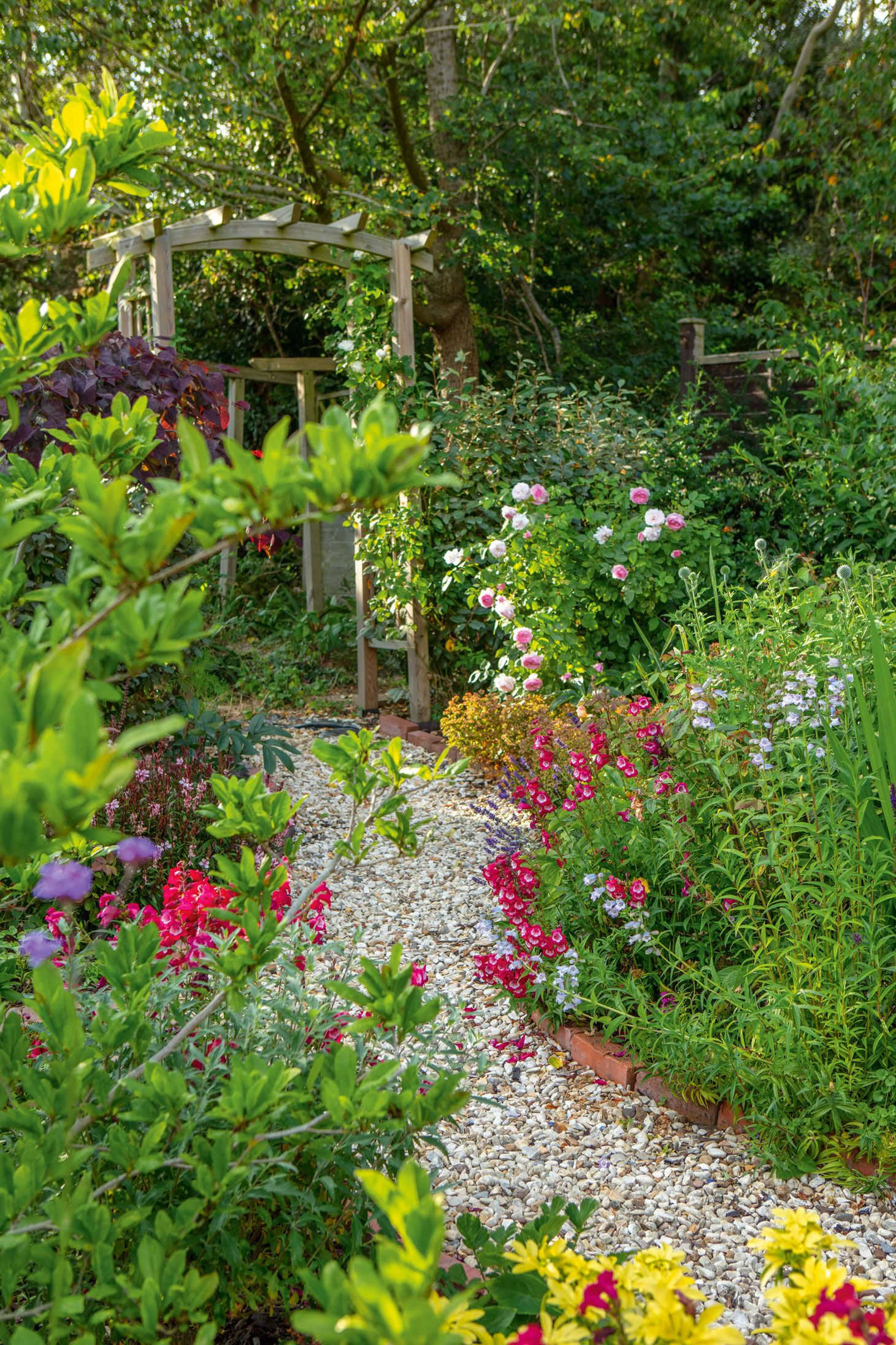
This is so easy to achieve. Pick plants that will flop over paths, tumble from arbors and pergolas, and scramble over walls and fences. This softens the hard landscaping so it fades into the background rather than being the dominant force as is often the case with more contemporary gardens.
It’s time to let nature takes its course too. Put away those secateurs and let your plants go on a rampage. Get a hazy effect with lady’s mantle (AKA Alchemilla mollis, used to edge the path here).
The soft lacy flowers form scalloped edging. And you can’t beat airy cow parsley to blend in hard boundaries. It’s like looking through a filtered lens to enhance things.
14. Fill your cottage garden with containers
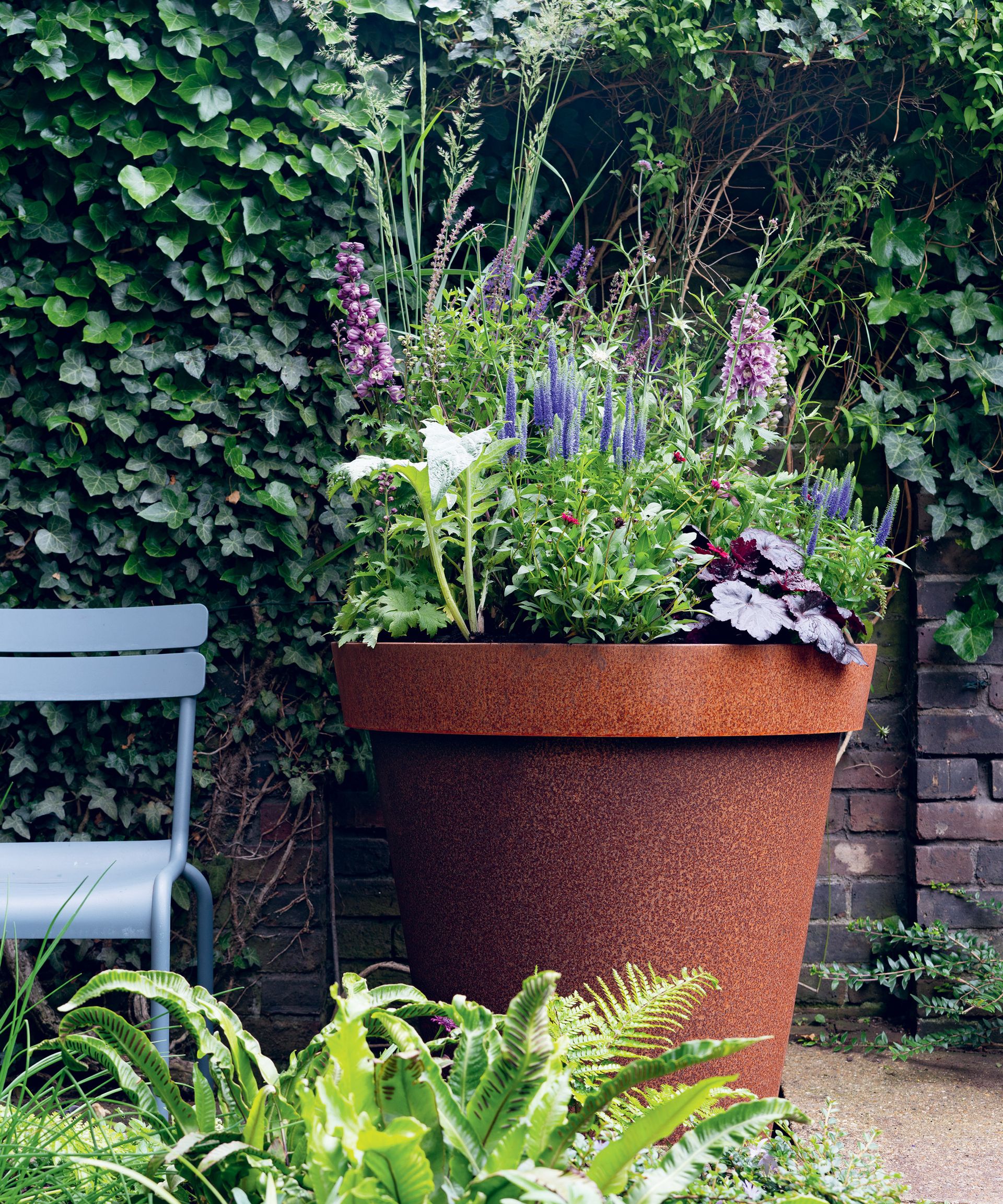
Container garden ideas provide the perfect way to punctate hard landscaping in your cottage ideas. They also offer wealth of other benefits too.
It is easy to control the soil mix – growing acid-loving plants, for example, when your have alkaline soil.
You can also plant earlier, as when the soil is too cold to grow in early spring, containers filled with snowdrops, anemones or bergenias can absorb the warmth of the sun from their higher ground. You can also use your containers to reflect the changes in the seasons, for example there are plenty of fall planter ideas that will help bridge the gap between high summer and your winter garden ideas.
If your garden is small or largely paved over, containers also work wonders to add cottage garden color and interest to your cottage patio ideas.
‘The choice of container material is endless,' says Isabel Palmer, founder of The Balcony Gardener (opens in new tab). 'Large-scale planters, such as dolly tubs, add maximum impact, while containers made from natural materials complement plants well – wicker planters create natural looking displays reminiscent of a cottage garden.
"‘Thriller, filler, spiller,’ is a useful phrase to bear in mind when choosing plants for the container. Select a strong statement variety to act as a focal point, and then complement it with filler plants – mixing upright choices at the back with compact ones arranged in the middle. Then add in spiller plants that will trail over the container sides.’
15. Bring in the bees
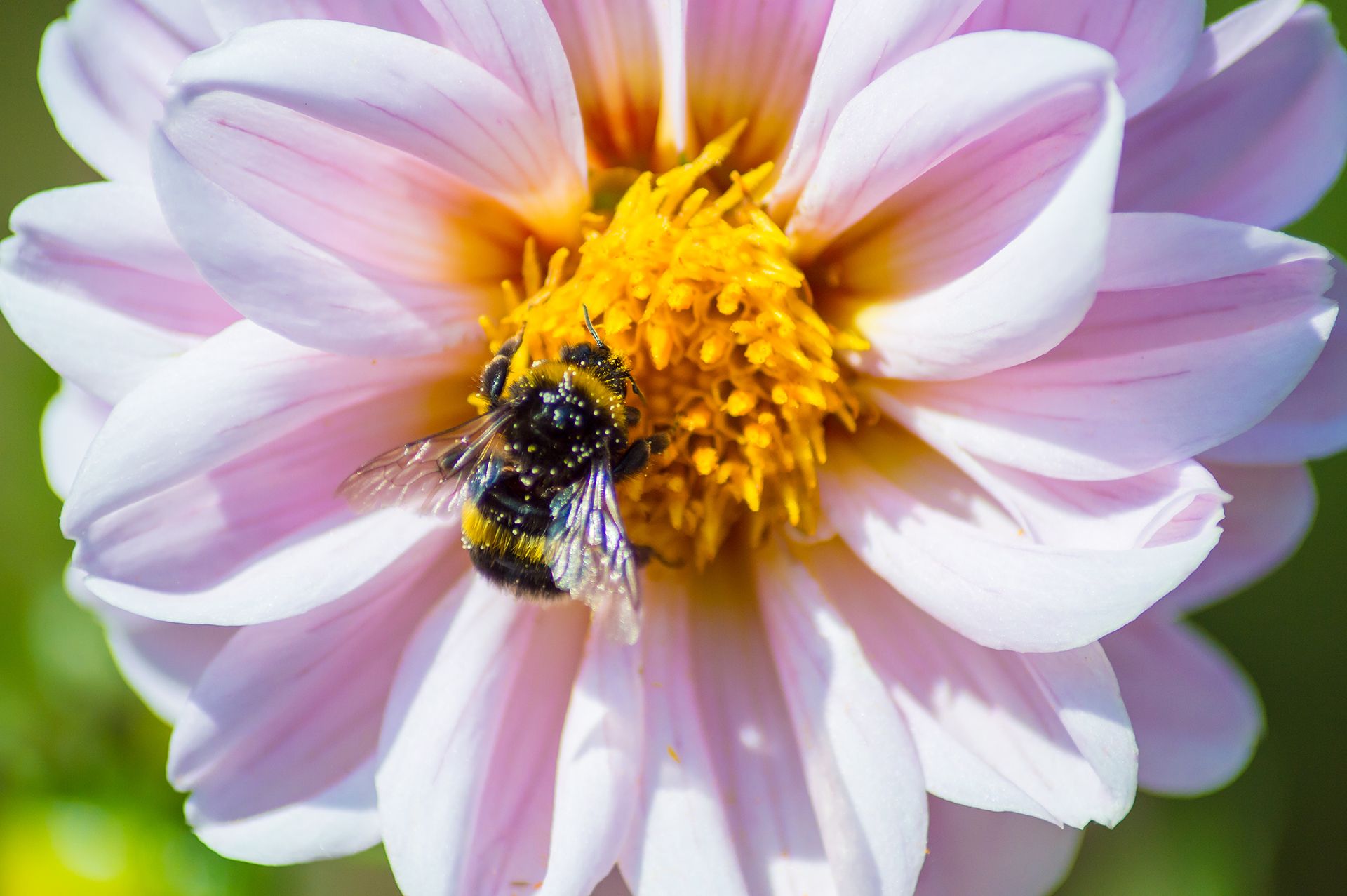
There are plenty of plants for pollinators but not all of these are flowers that attract bees. Ana Mari Bull avoids plants which are wind-pollinated as they don’t need the help of insects. She advises that double flowers, though attractive in a cottage border, should be avoided as bees can’t get into the plants and many are sterile.
For summer Ana likes geranium ‘Rozanne’ for small gardens and lavender for low hedging to edge a path. But late winter and early spring supplies of pollen are important. She says ‘Hellebores, cyclamen, primroses, crocus, lamium, galanthus, eranthis and winter flowering clematis with be a food source for early emerging bumble bees, who can fly at lower temperatures than other bees.
‘Borage flowers refill their nectaries every couple of minutes so are perfect for bees and other pollinators. The flowers can be added to Pimms too,’ concludes Ana Mari Bull.
16. Introduce fragrant plants
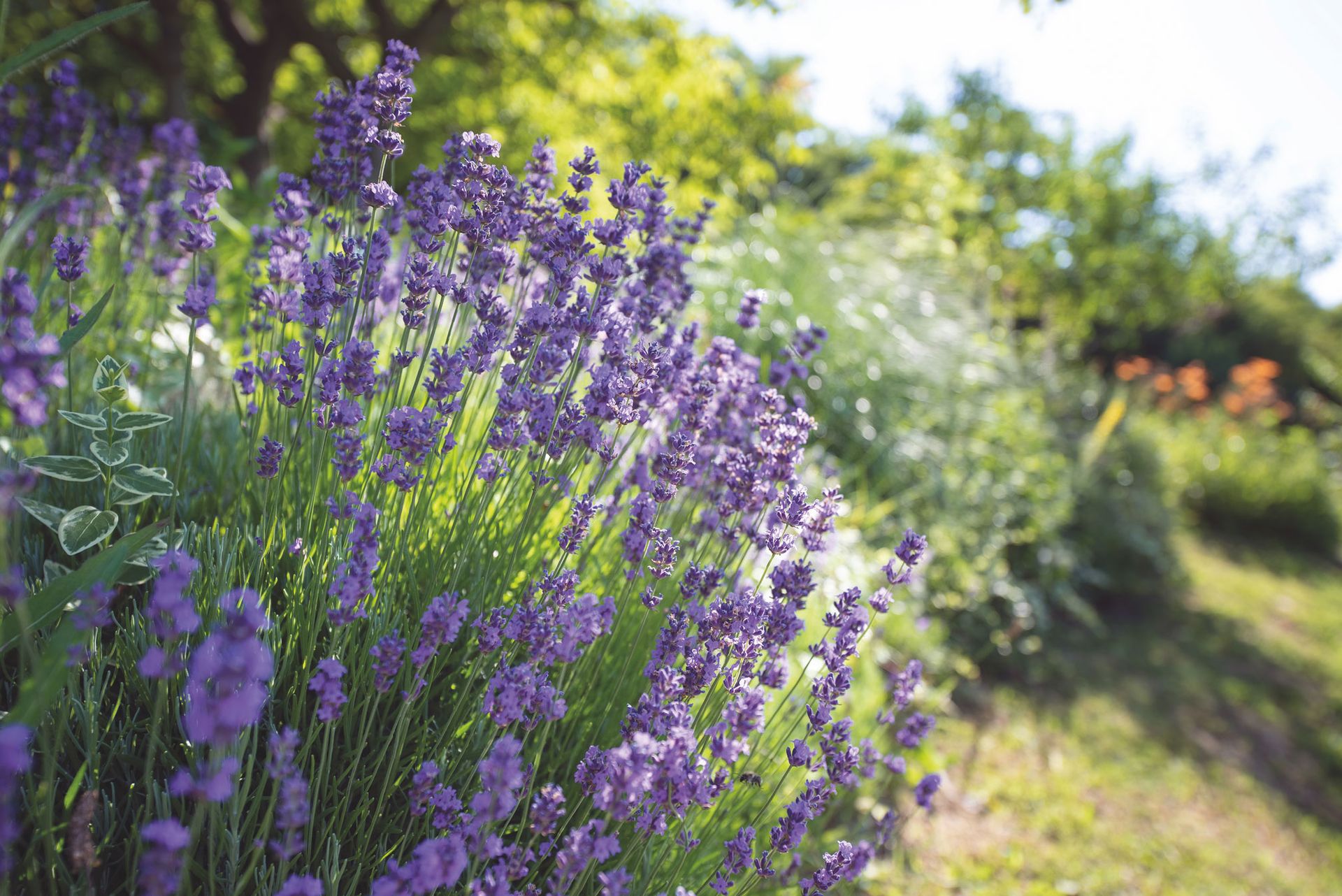
The scent of lavender and the soothing buzz of bees hovering around it on a summer’s day are a traditional but timeless feature of the cottage garden.
Plant lavender near a path or doorway so you can brush your fingers through the scented leaves as you pass by.
A heavenly fragranced rose scrambling over an arbour will envelop you as you wander underneath, while a twiggy wigwam of sweet peas will drench the air with their old-fashioned scent.
Other favorites for packing perfume into borders include frilly garden pinks and sweetly honeyed phlox, while a perfumed lilac bush always works well and is a butterfly magnet too.
17. Grow your own plants in a greenhouse
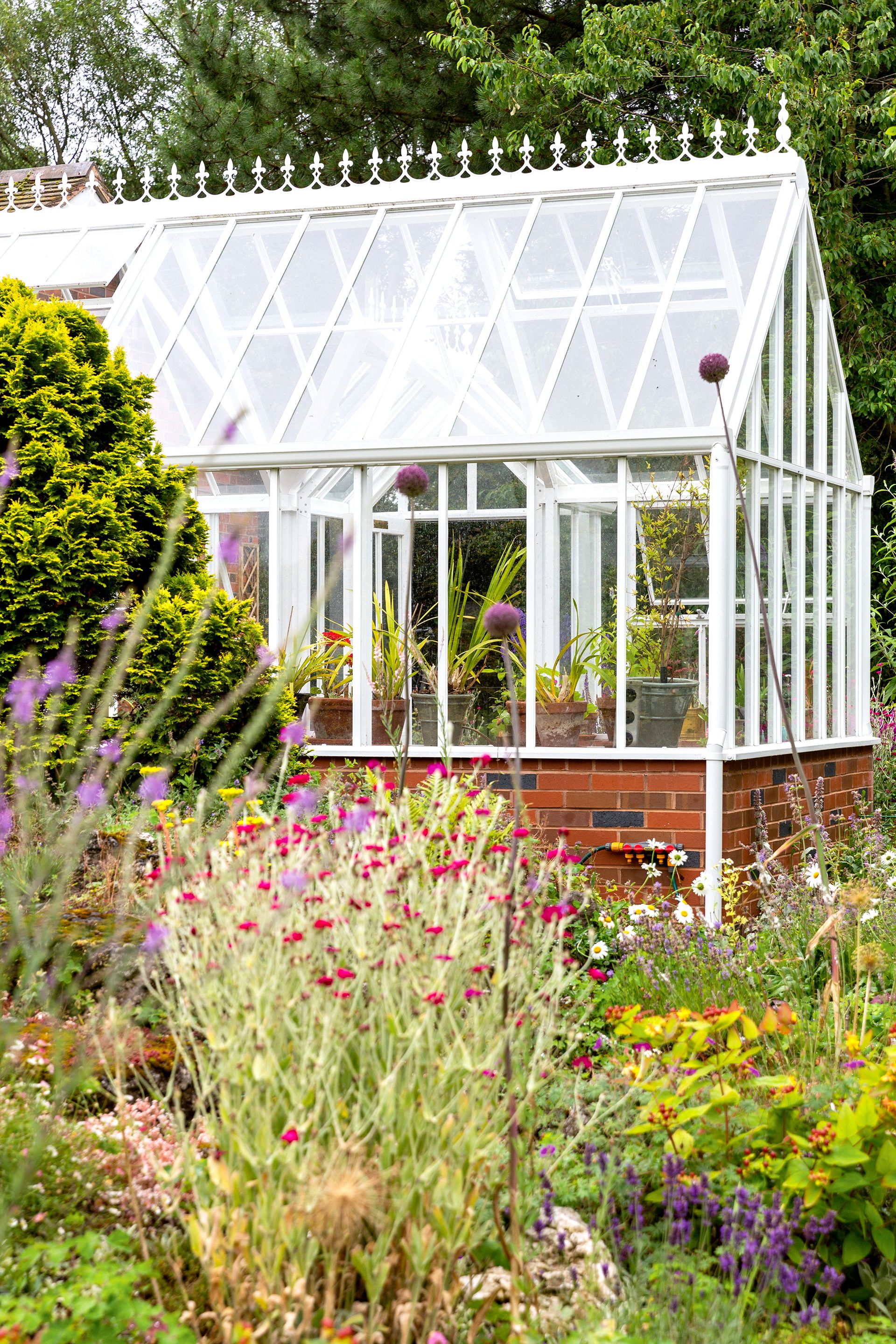
There is no better way to get closer to your plants than by growing them from seed, and so one of the best cottage garden ideas is to include a greenhouse or glasshouse.
‘Glasshouses are intrinsically linked to a romantic, comforting notion of Englishness,’ says Martin Toogood, chairman of Hartley Botanic (opens in new tab), which creates luxury glasshouses for both the US and European markets.
As we approach summer, greenhouse ideas can take on a multifunctional purpose in a cottage garden, used as more than just a growing space, but somewhere to enjoy spending time, immersed among the plants. ‘We see customers introducing relaxation, dining and lifestyle elements into their greenhouse, and we expect this trend to grow, particularly this summer as we come back together post lockdown,’ adds Toogood.
Some of the best cottage garden plants are annuals or short-lived perennials, so you will be able to nurture beautiful plants in your own growing space.
Plantswoman Sarah Raven (opens in new tab) has a particular love for traditional cottage garden plants. One of her favourites that can be easily grown from seed, is foxgloves: ‘They make some of the very best cottage garden early summer garden plants and cut flowers,' she says. 'If you pick the king flower – the main spire, you create lots of prince flowers and the plants will then go on flowering for longer.'
18. Pick flouncy cabbage roses
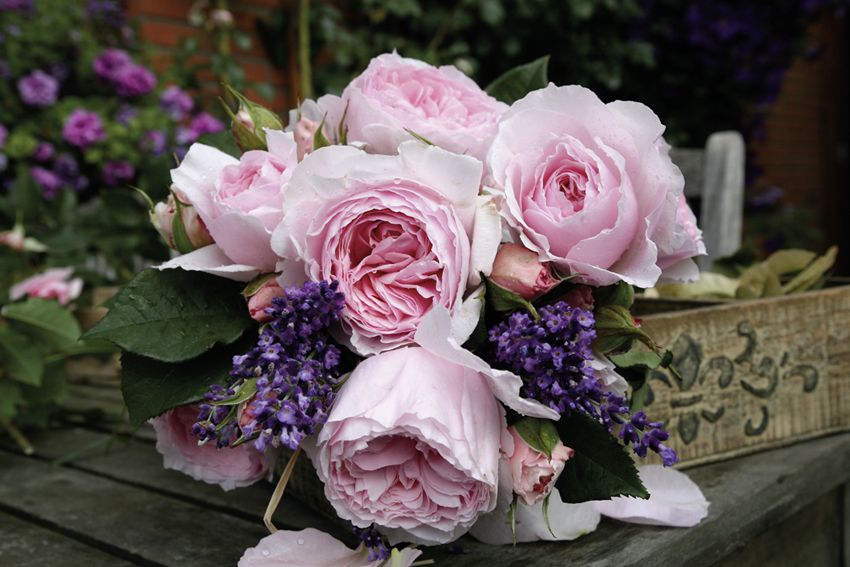
With their big, blowsy blooms and glorious scent, old-fashioned roses add a dusting of magic to the cottage garden. Available in a range of opulent colors, their silky ruffled petals pack an old-style glamour punch. They are the ideal flowers for creating a sense of romance in your cottage garden too.
Opt for something like this ‘Enchrantress’, a stunning double pink ruffled rose with densely packed velvety petals that gets a top rating scent wise and is also what’s known as a ‘repeat flowerer’.
Remember to keep snipping off any faded blooms and you'll be rewarded with a second flush. It has a good vase life too, and looks gorgeous paired with lilac.
19. Add a secluded spot to sit

Don’t forget to plan seating areas in your cottage garden. Positioning a bench in a secluded spot – beneath a tree with low branches, or an arch covered with roses or wisteria – will immerse you in the sights and scents of your garden, and enable you to take in the view.
Think carefully about where you place your seating, so that you can get the best vista to appreciate all your hard work. Choose a spot that isn’t overlooked by neighbors and offers some shade from the glare of high summer sun.
20. Plant around a focal point
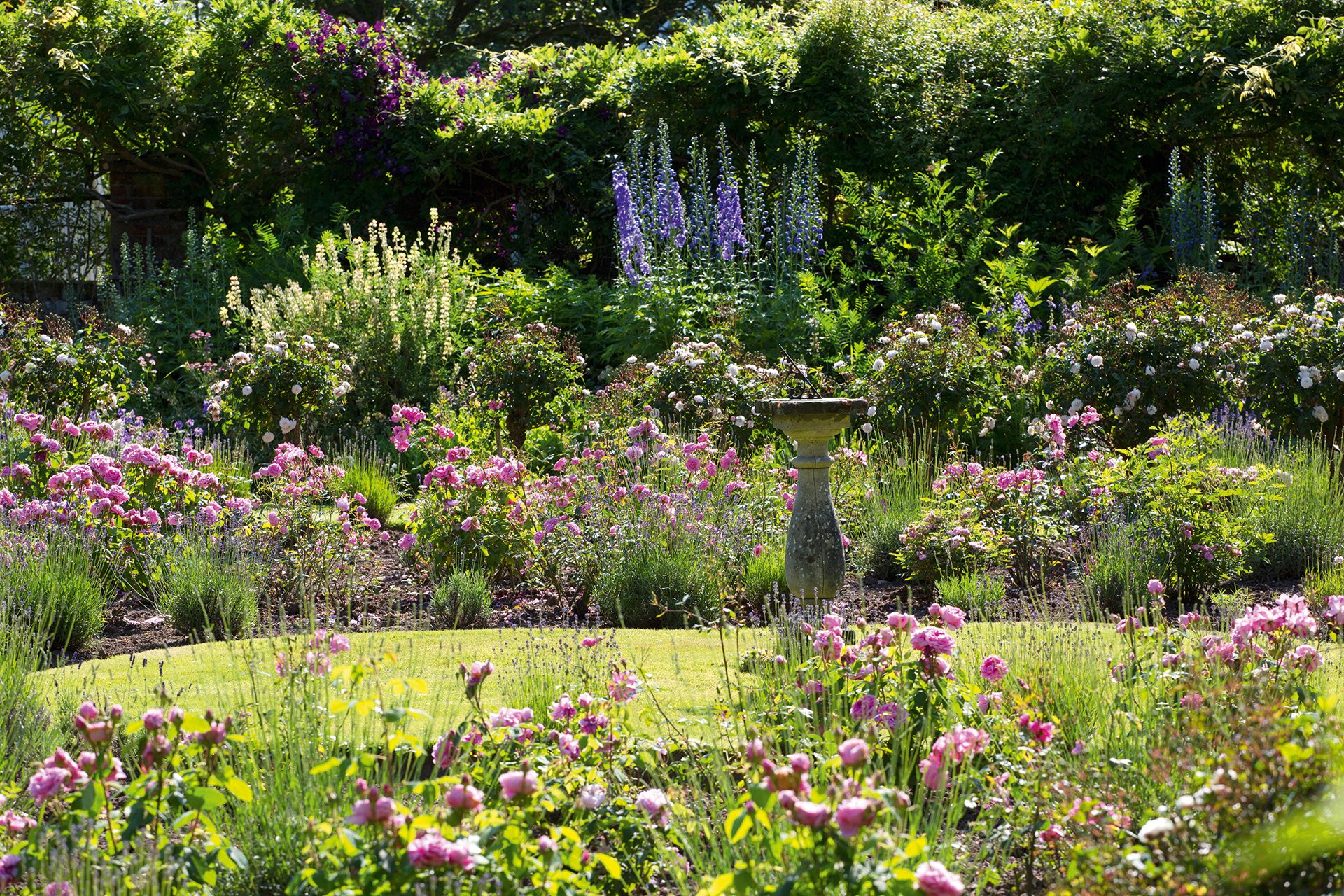
Adding a few key focal points or yard art ideas to your cottage garden is important to help draw the eye, and create a gentle sense of purpose and structure, without overlapping into formality.
A bird bath surrounded by borders, a trickling water feature, a colorful container display, or a romantic rose arch – all these cottage garden ideas will help you to appreciate the wider scheme you have created.
21. Make a vintage display
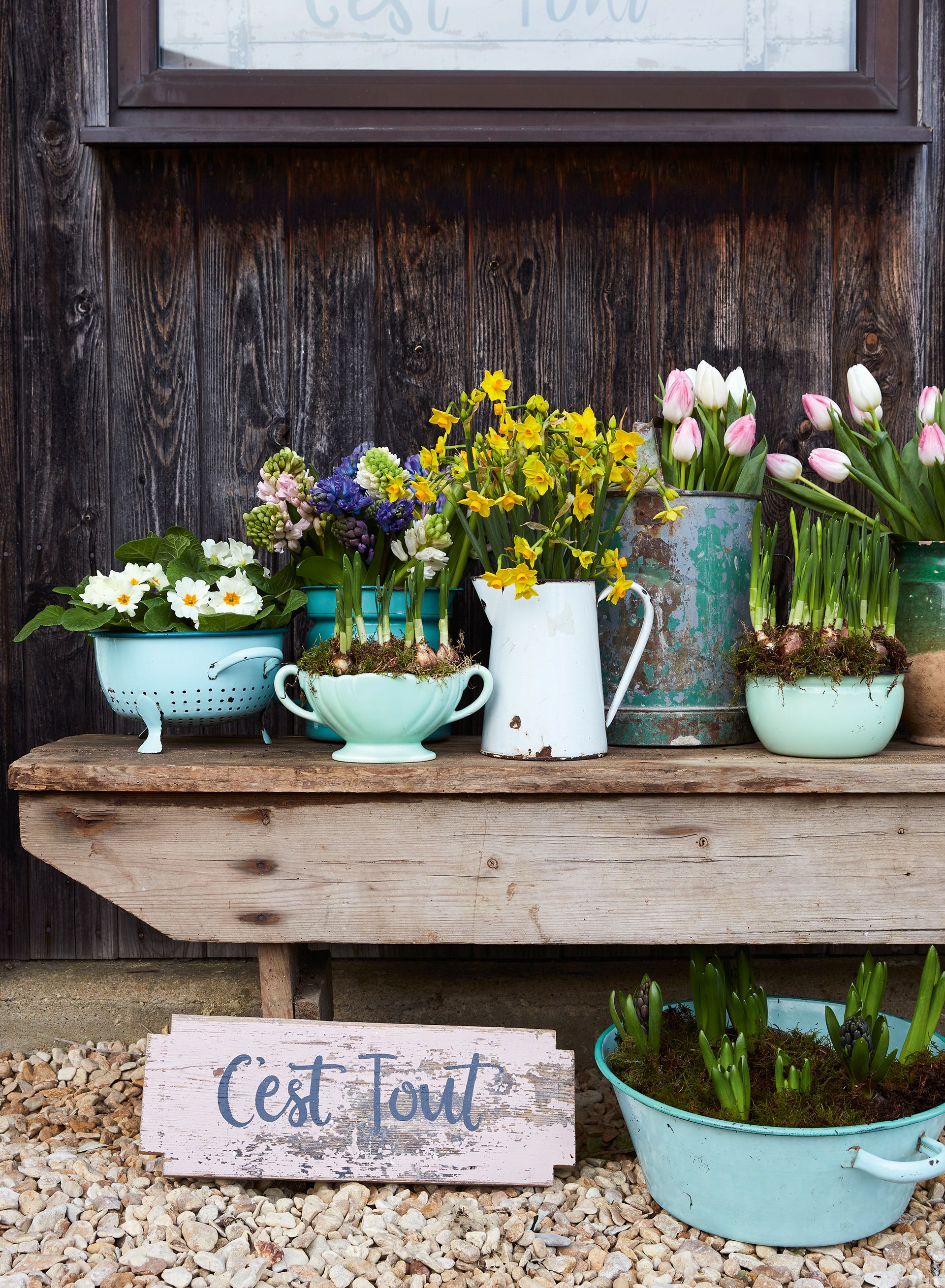
Vintage pieces add rustic charm and a sense of history to a cottage garden. Consider how fleamarket finds can be repurposed as planters, and use them together to make a striking display. Timeworn metallic containers work particularly well as a foil for bright spring flowers.
Also keen an eye out for whimsical signs, outdoor furniture and cast iron items that could be used to display plants on.
22. Get the picket fence look

Traditional white picket fences are the signature look for a cottage garden. Also known as palisade fencing, back in the day they were the obvious choice as they were simple to construct on site with standard pieces of timber.
The fence was often painted white to improve longevity and it’s this iconic look that we've grown to love. Now there are new long-lasting products on the market to achieve the same look with modern materials that don’t require upkeep. Once they're in position all you need to do is plant a mass of blooms that will peek over and through the panels.
23. Make doorways pretty
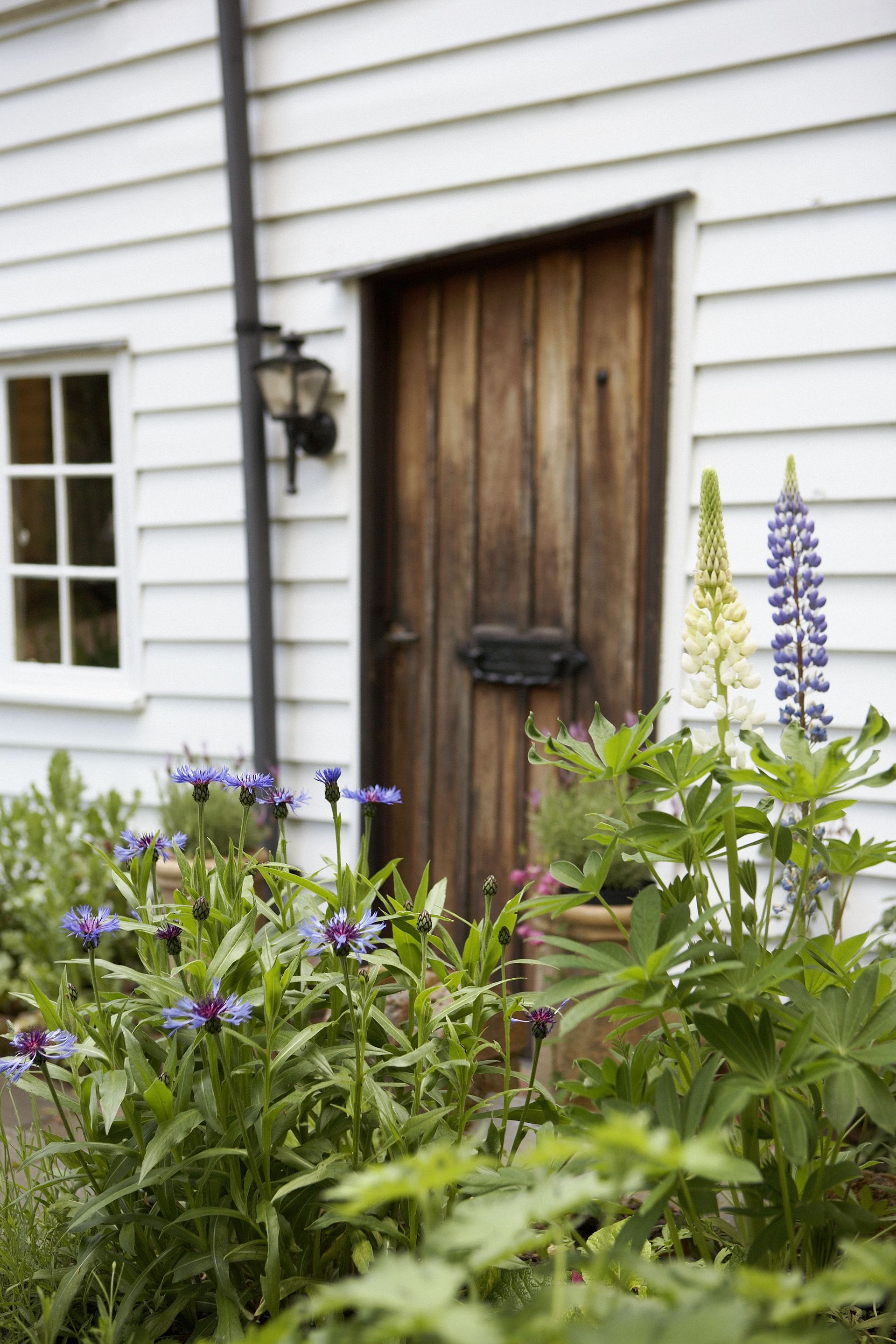
Set the scene by framing doors and windows, both front and back, with pretty collections of flowers and foliage in a restrained color palette that fits with the exterior scheme of your house.
Add perfumed plants to the mix too. As you walk up your path one of the most welcoming sensations on arriving home is being hit by a delicious waft of fragrance so a pair of planters (we love these terracotta chimney pots – what could be more cottage garden?) with lavender will give your entrance the standout factor.
Combining with inviting cottage porch ideas helps to create the right mood and lets you show off your passion for plants too. Tap into cottage vernacular by choosing classics like lupins and perennial cornflowers, then let them romp around in a naturalistic way.
24. Escape to nature with dreamy lilac
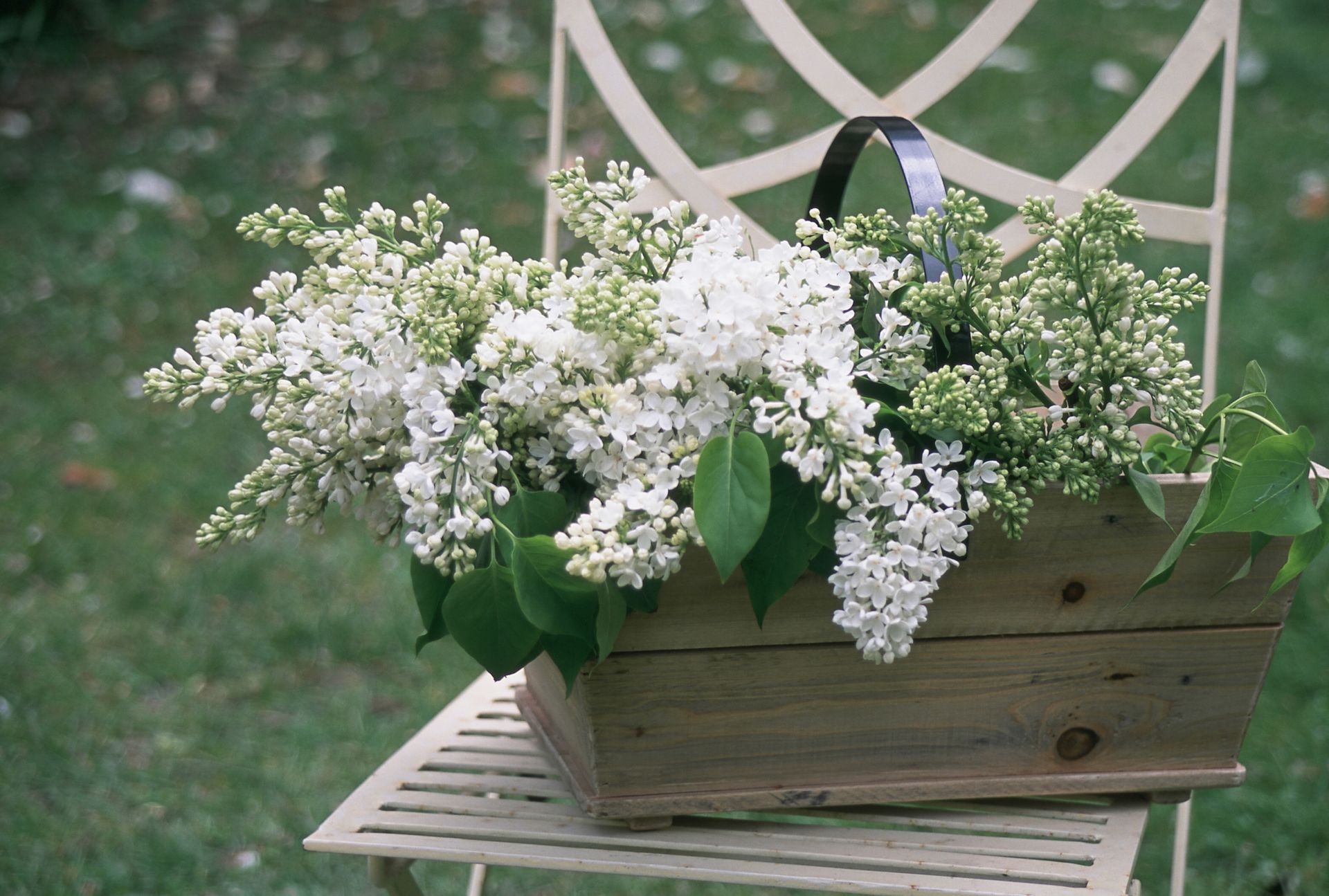
The most magical of plants, lilac is one of the cottage garden shrubs of old that’s rightly having a comeback. A longtime favourite of cottage planting schemes, where it was once considered the height of fashion, it grows easily and the showy cones of blossom come in a range of pretty shades as well as signature soft mauve.
Some of the oldest varieties are known as French Lilacs. The lush double flowers of ‘Mme Lemoine’ are pure white and the heady perfume is incomparable so it easily earns its place in the cottage garden.
Lilac can be grown as a tree, a shrub or in a pot according to variety, and adds a pleasing shape to the structure of your planting.
25. Plant in romantic drifts

This is a signature look for cottage gardens, where swathes of naturalistic planting is used to create a loose and unstructured effect. It’s easy to do too. Just remember you’ll need three, five or seven lots of each plant, then arrange them in repeat groups for impact.
One of the most distinctive cottage garden plants with their tall spires of speckled bells, foxgloves are a natural choice for this look. Drift planting works best when it creates a gentle wash of color, so foxgloves are perfect for the job as they come in a range of dusky pink, soft apricot and misty mauve shades.
Add punctuation marks to the structure of the planting scheme with pompom plants like agapanthus or alliums, also planted in repeat patterns.
26. Add stunners to fill borders
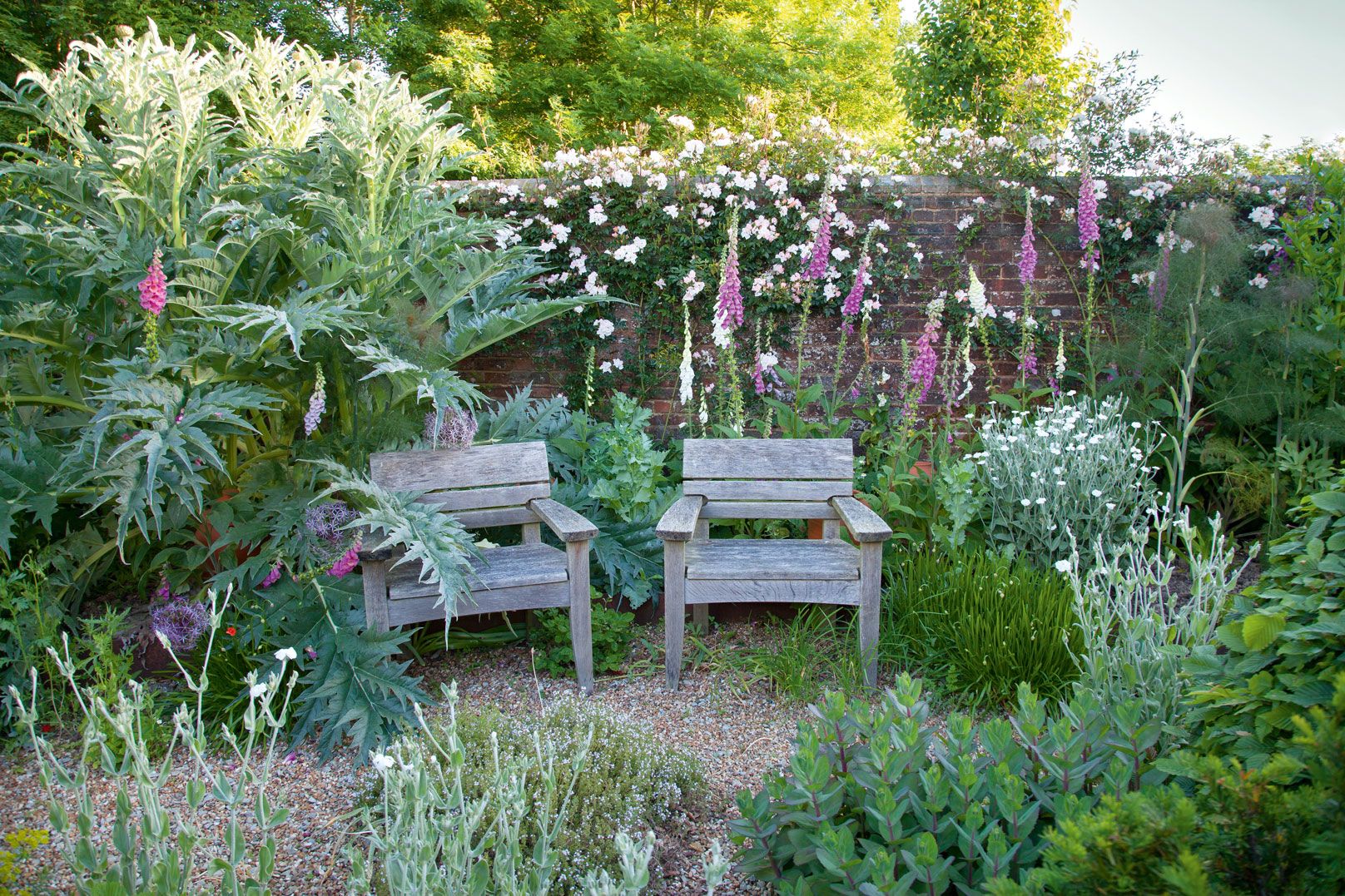
Choose dramatic spikes with striking vertical lines and big showy plants with larger than life leaves to add show stopper moments to a cottage planting scheme. If you want drama in your borders opt for statement plants like these.
For attention seeking towering spires go for showy lupins, delphiniums and foxgloves as they will always catch the eye. A few vertical notes from plants like this will lift a run of the mill border and turn it into something special.
The huge, silvery, thistle-like leaves of towering cardoons make it a stunning addition to the back of a border. Just perfect for some leafy seclusion in your favourite relaxation spot.
27. Choose a cottage garden classic
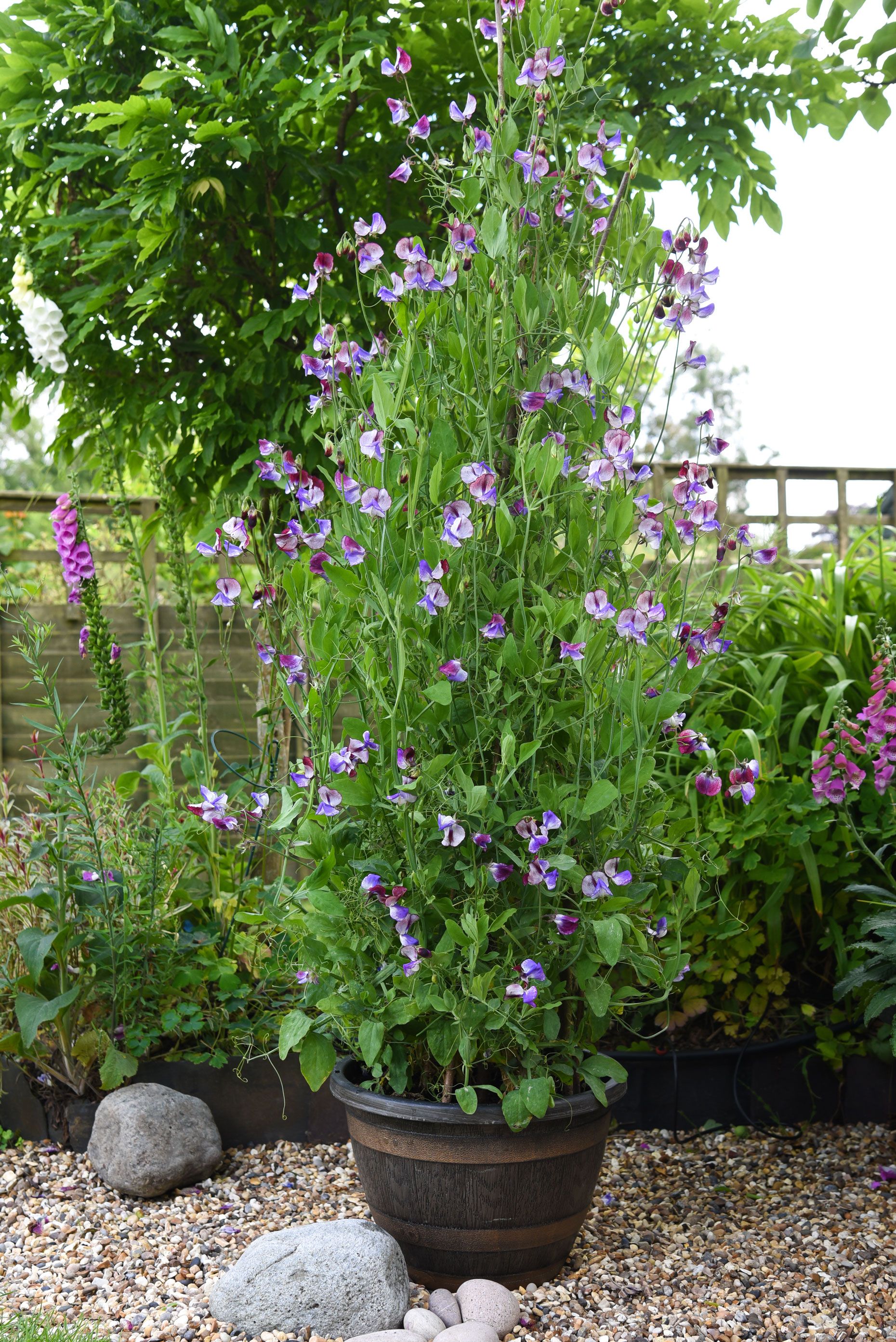
Adding fragrance, color and height, traditional sweetpeas would have to be your first option if you could only choose one plant. Once you know how to grow sweetpeas, they will quickly become an integral part of your cottage garden ideas.
Give them a wigwam of hazel branches to scramble up and over and sweet peas will be off, their tendrils winding through the twiggy frame to create a sensational summer display.
'Three Times As Sweet' is new – and the first cultivated modern grandiflora variety, with a ton of that lush, rich and evocative scent that's the signature of these cottage garden classics.
The tri-color blooms of this variety blend lavender-blue, purple and white to create an eye-catching display that's just the perfect finishing touch to a cottage garden.
28. 'Right plant, right place'
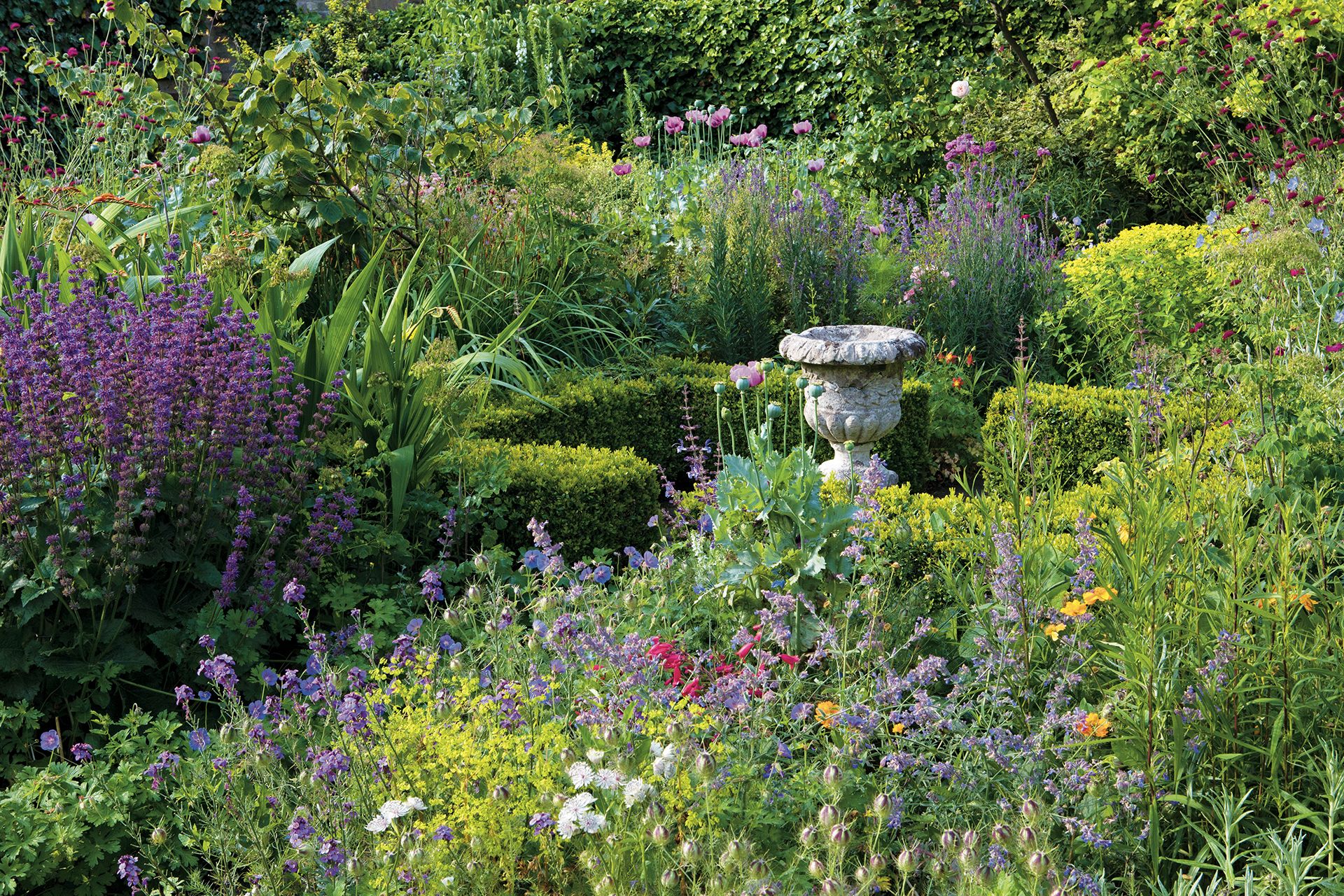
‘Always think right plant, right place,’ says garden designer Rosemary Coldstream (opens in new tab). Your plants have the best start possible being in their ideal soil and sun conditions, so bear this in mind when selecting your plants. From there Rosemary recommends deadheading plants regularly to prolong flowering.
If your border is either heavy or very dry then mulch it with a good quality compost. Looking to the long term if clumps get too big then lift and divide them to grow your space even more and prevent overcrowding.
29. Combine edibles with flowers
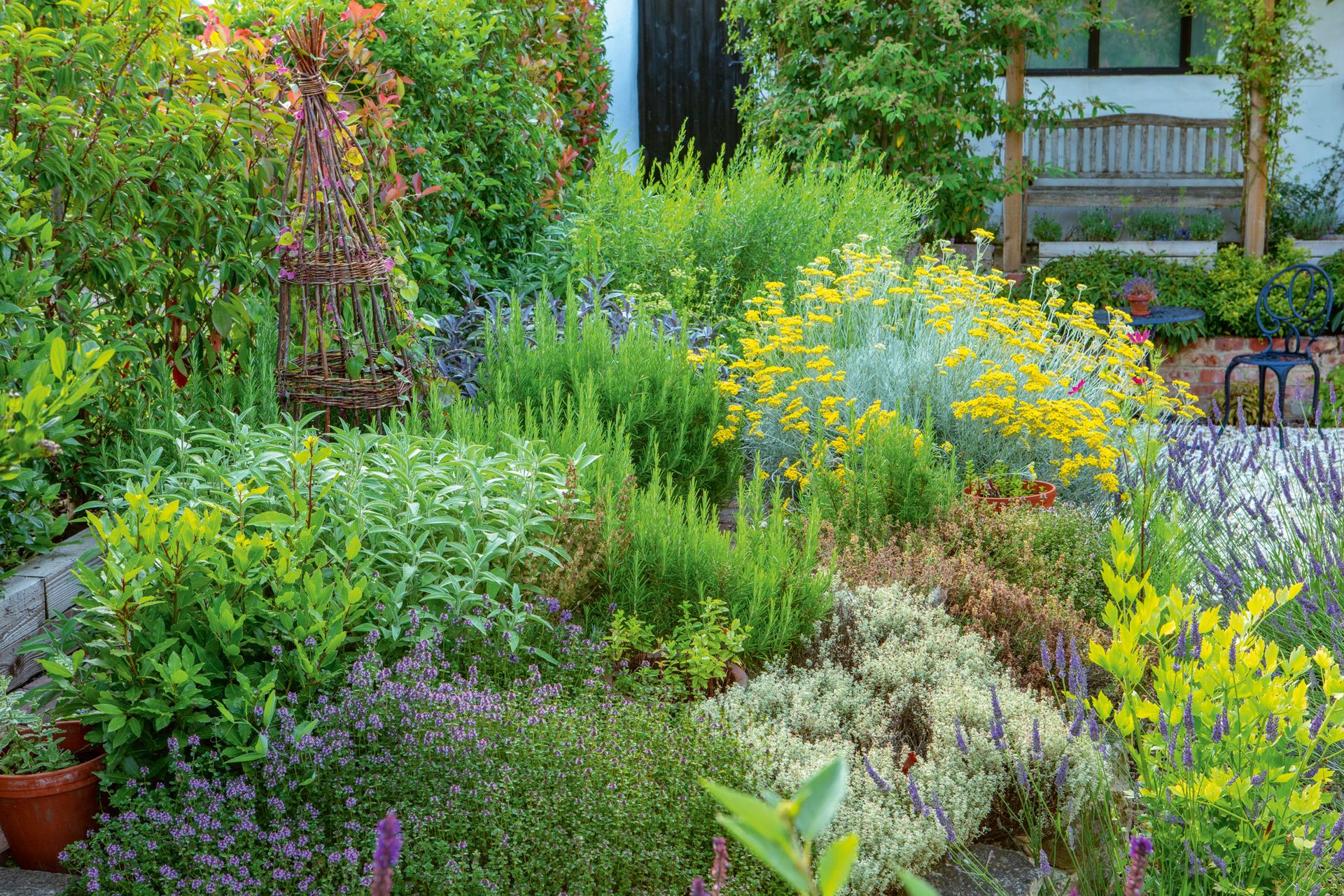
'The traditional cottage garden encapsulates a hand-made, do-it-yourself style of gardening so when it comes to planting include a mix of simple flowers and edible plants,' says Debbie Roberts of Acres Wild (opens in new tab).
Herb garden ideas can include 'scented, herbal and healing varieties will by definition be beneficial to butterflies and bees, and when combined with some good structure you will have a chocolate box image of a cottage garden.'
30. Consider function and form
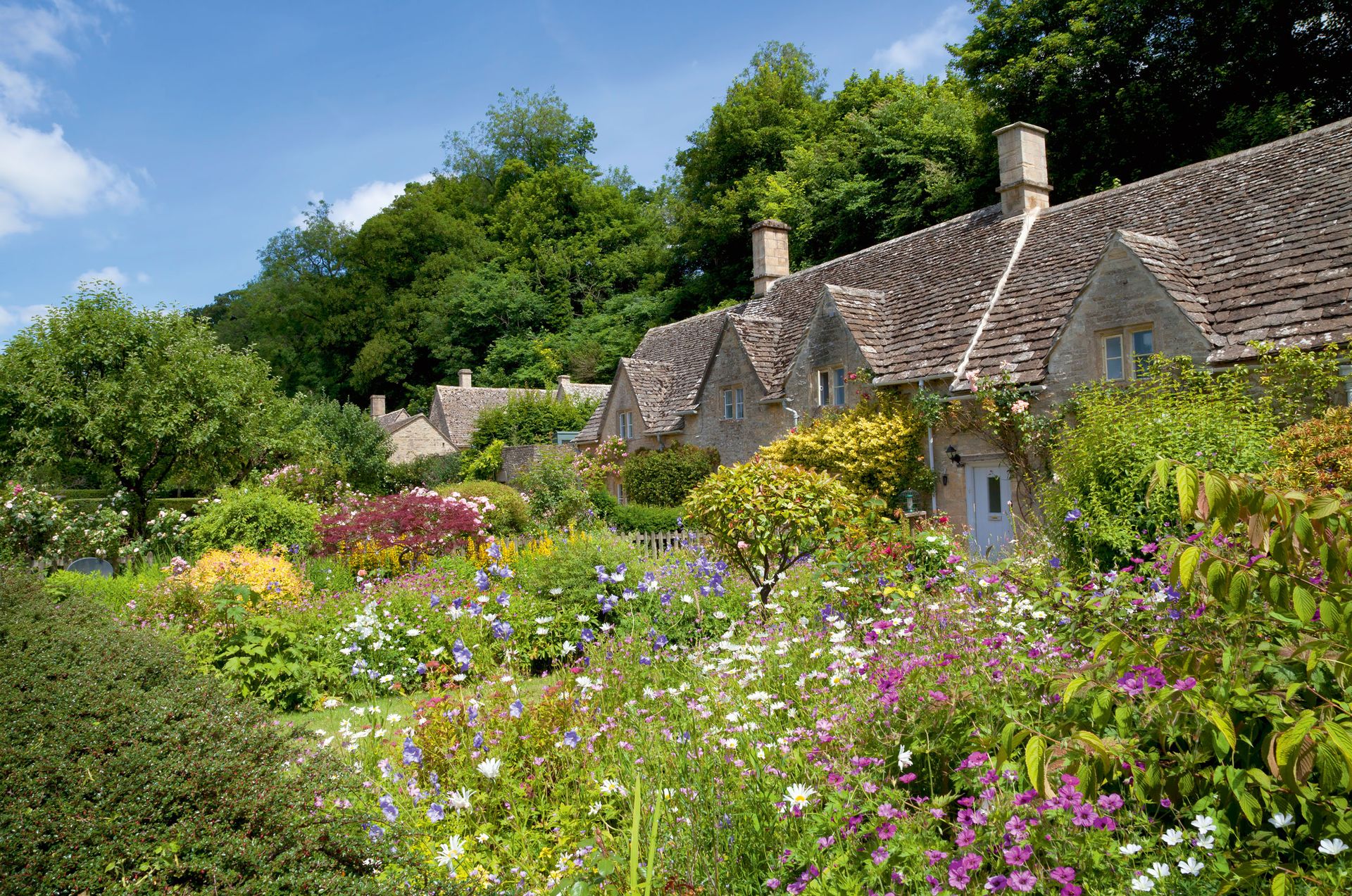
'A cottage style garden still needs to function in terms of design, so routeways and destinations still need to be considered, somewhere to sit in sun or shade, along with good views to exploit and eyesores to screen, perhaps with a carefully located blossom tree for bees and that will also provide berries for birds later in the season,' continues Debbie Roberts.
'The idea here is to create an ambiance to transport you to a time and place and disguise anything that detracts from this.'
31. Choose the right hard landscaping

When you are considering backyard landscaping ideas, think: local.
'Locally sourced, natural materials and building techniques ground a garden in its place and would have been what was used in the past. Nearby salvage yards and local stone suppliers would be a good starting point for paving materials and search out local craftspeople for furniture and ornamental additions,' continues Debbie Roberts.
'For terraces and pathways reclaimed stone is ideal, along with brick, if this chimes in with the locality, and gravel (cinder would often have been used in the past).
'Small ornamental pieces may be salvaged and randomly arranged.'
32. Consider a cottage garden water feature
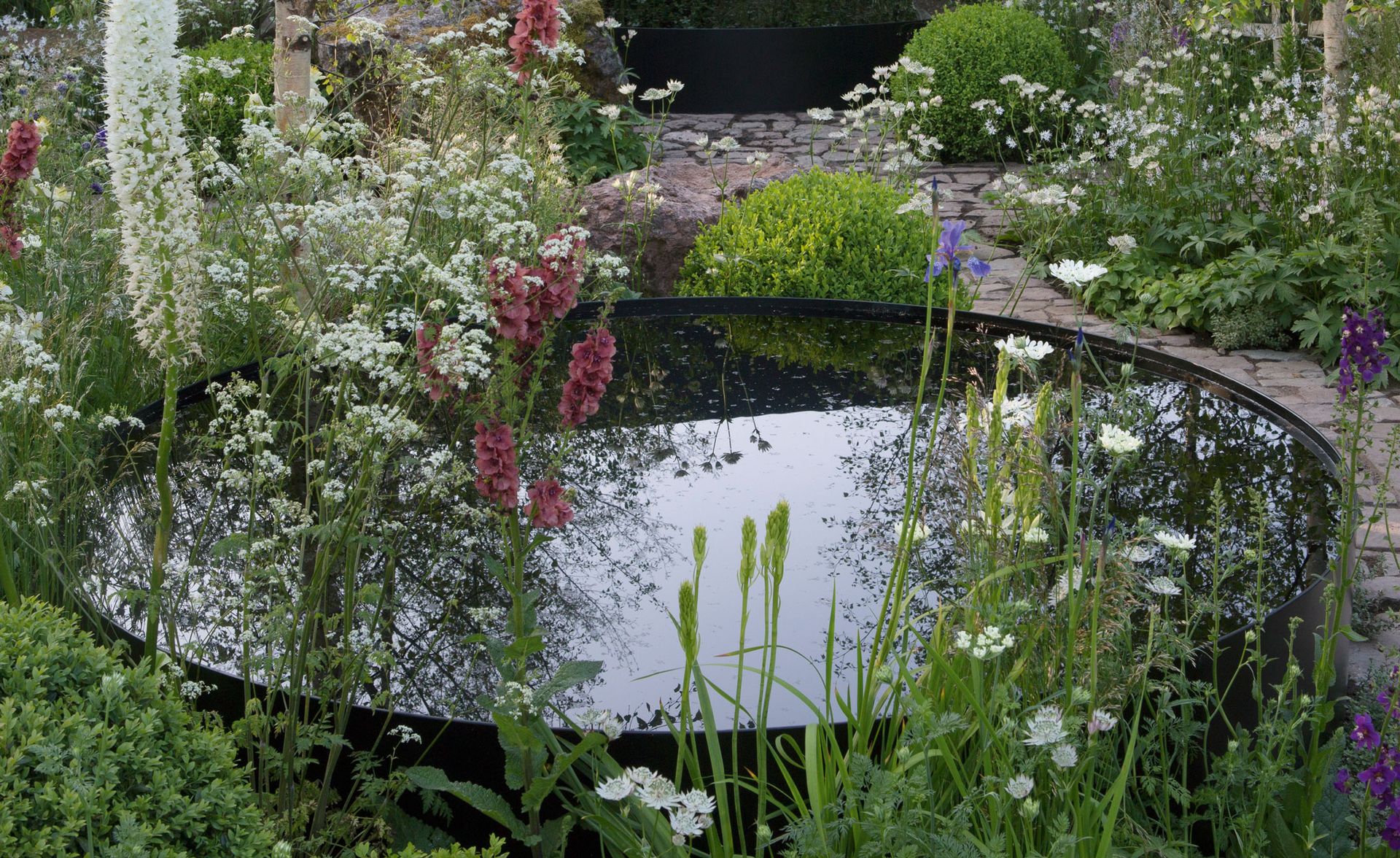
Cottage gardens should always include pond ideas.
'Water might be used to animate the space. A salvaged stone trough with a hand pump for instance wouldn’t look out of place in a cottage garden. If a pond were to be considered in the overall layout it would be appropriate if it were designed to encourage wildlife and so increase the biodiversity of the garden,' concludes Debbie Roberts.
How do you lay out a cottage garden?
When deciding how to layout a cottage garden, the trick is not to overthink it. Cottage gardens are traditionally simple and regular in layout, with a path to the door, and rectangular beds on either side packed with unrestrained planting.
Hedges and decorative topiary can be used to divide the garden into a series of enclosed spaces with different planting themes.
The combination of soft and riotous planting with formal clipped hedges and decorative topiary works as a design contrast.
Choose natural stone, reclaimed brick, setts and cobbles, and other found materials to add structure but blur the edges seamlessly with moss, lichen or creeping plants like scented thyme filling the gaps.
Gravel pathways and simple picket fences also suit this naturalistic design style. Add twists and turns with curves and wilder planting to introduce elements of surprise, while romantic arbours or arches with blooms scrambling over them frame entrances to other areas.
How do I start a cottage garden from scratch?
To start a cottage garden from scratch, the key is to plant traditional flowers and plant at the right time of year. Garden landscape designer Fi Boyle (opens in new tab) MSGD explains that there are two key times of year to plant. ‘The first is the early autumn when the soil is still warm and not waterlogged but everything is starting to die back and settle in for the winter.’
For Fi, the advantage of planting in the autumn is that the plants settle into warm earth and start to establish their roots before the winter. This means that when spring comes they are ready to get going.
However, if you have missed the autumn window fear not, you can also plant in spring and this does work just as well. You may need to keep a bit more of an eye on your plants as in recent years we have had very dry springs. Fi recommends giving plants a good soaking from time to time while they’re establishing.
How do I set up a cottage garden on a budget?
You can set up a cottage garden on a budget by growing plants from seed and allowing others to self-seed in your garden. In fact, cottage garden ideas are one of the easiest styles to set up on a budget. The look is unpretentious and informal, and borders and containers can be filled with many plants that you can grow yourself from seed or propagate from cuttings.
Consider arranging a seedling swap with friends, so you can share your home-grown wonders, and make your garden more diverse. Also learn how to take plant cuttings to multiply your collection of plants for no additional cost.
Scour vintage stores and fleamarkets for old garden furniture, pots and vessels that can be repurposed for the garden – anything from crates to ceramic sinks.
Remember – gardens are not created overnight; they evolve over years. Keep adding to it and, before you know it, you will have created your own dream cottage garden.
What is a cottage garden style?
Cottage garden style is characterised by dense planting, profusion of color, and mix of different flowers used in pockets of planting with different themes. While many cottage gardens stick to simple patterns, others are more relaxed with paths delineating spaces, although any geometry is blurred by the generous planting. It’s an informal style that feels ‘undesigned’ and the appeal lies in getting the mix right. You can't beat this style of planting to give your garden the standout factor every time.

Lifestyle journalist Sarah Wilson has been writing about gardens since 2015. As well as homesandgardens.com she's written for Gardeningetc.com, Livingetc.com, Easy Gardens and Modern Gardens magazines. Her first job on glossy magazines was at Elle, during which time a visit to the legendary La Colombe d'Or in St-Paul-de-Vence led to an interest in all things gardening. Later as lifestyle editor at Country Homes & Interiors magazine the real pull was the run of captivating country gardens that were featured.
- Holly ReaneyContent Editor and Sub-editor
- Melanie GriffithsEditor of Period Living
-
-
 7 expert-approved methods to remove candle wax from carpet
7 expert-approved methods to remove candle wax from carpetCleaning professionals share their tips on how to remove candle wax from carpet
By Millie Hurst • Published
-
 Are you making these critical design mistakes in your small home office? Experts reveal 7 they always avoid
Are you making these critical design mistakes in your small home office? Experts reveal 7 they always avoidWant to know what's wrong with your workspace? Experts reveal the top 7 design mistakes we're making in our small spaces
By Zara Stacey • Published

